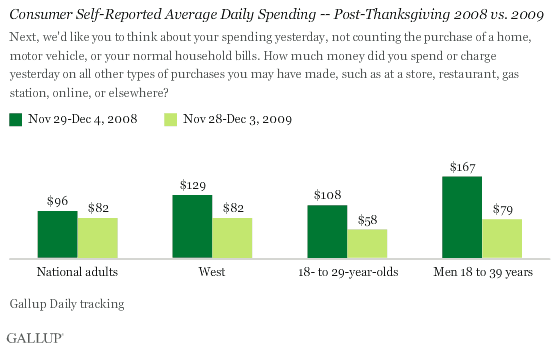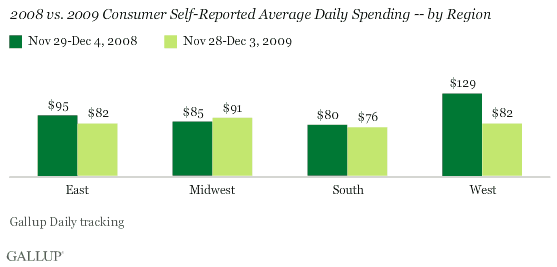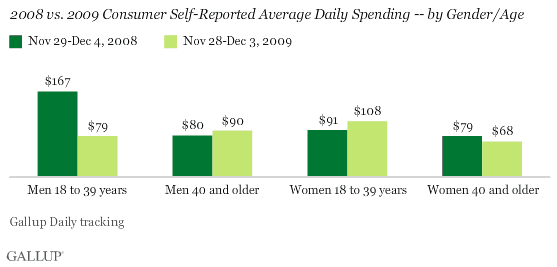PRINCETON, NJ -- The 2009 holiday retail season, which kicked off last Friday, has been marked by somewhat lower self-reported consumer spending than was seen during the comparable period a year ago. According to Gallup Daily tracking, daily consumer spending for the six-day period since Thanksgiving -- spanning the Black Friday weekend and Cyber Monday -- averaged $82. This is down 15% from $96 for the same six-day period in 2008.

Each day, Gallup asks Americans to say how much money they spent "yesterday" in stores, gas stations, restaurants, or online -- not counting home and vehicle purchases, and their normal monthly bills. The reduced retail spending at the outset of the holiday shopping season this year compared to last is most pronounced in the West, among young adults, and more specifically among men aged 18 to 39. Only slight, and not statistically significant, changes are seen by household income and parental status.
Regional Spending
The year-to-year spending trend for the first week of the holiday shopping season appears to be fairly flat in all regions of the country, except for the West, where spending has dropped by more than a third, from $129 to $82. This could reflect the poorer jobs situation in the West compared to other regions, which Gallup documented earlier this week.

Spending Patterns by Age
Spending levels among adults aged 30 and older are quite similar to what they were in 2008. However, spending among 18- to 29-year-olds is down sharply.

The decline in spending among young adults is seen exclusively among men. Post-Thanksgiving daily retail spending among men aged 18 to 39 has averaged $79 this year, down from $167 in 2008's post-Thanksgiving week. By comparison, spending among women in that age group shows a modest but not statistically meaningful increase.

The $167 that younger men spent last year at this time was significantly higher relative to other age/gender groups than is normally seen; thus, the drop between 2008 and 2009 may be somewhat exaggerated and it will be important to monitor spending patterns by these age and gender categories as the holiday season progresses.
Bottom Line
Throughout the year, Gallup has found self-reported consumer spending to be running substantially below the comparable months for 2008, and it appears that pattern is continuing as the holiday shopping season kicks off. Some segments of society -- particularly younger women and residents of the Midwest and the South -- are managing to spend the same as or even a little more than they did a year ago, making them potential targets of last-minute marketing efforts by holiday retailers. Other segments -- particularly Westerners and men under 40 years of age -- are being quite cautious at the cash register, resulting in dampened overall spending figures.
Survey Methods
For Gallup Daily tracking, Gallup interviews approximately 1,000 national adults, aged 18 and older, each day. The Gallup consumer spending results are based on random half-samples of approximately 500 national adults, aged 18 and older, each day.
The 2009 consumer spending results reported here are based on telephone interviews conducted Nov. 28 to Dec. 3, 2009, with 2,866 adults. For these results, one can say with 95% confidence that the maximum margin of sampling error is ±2 percentage points. The 2008 results are based on telephone interviews conducted Nov. 29 to Dec. 4, 2008, with 3,034 national adults. For these results, the maximum margin of sampling error is ±2 percentage points.
Interviews are conducted with respondents on land-line telephones and cellular phones.
In addition to sampling error, question wording and practical difficulties in conducting surveys can introduce error or bias into the findings of public opinion polls.
